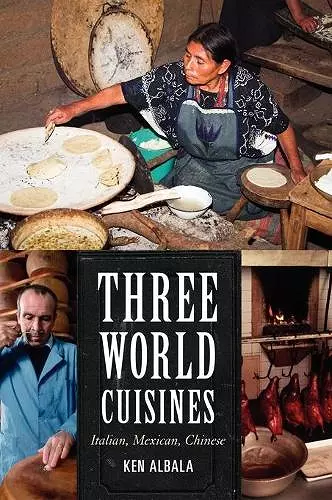Three World Cuisines
Italian, Mexican, Chinese
Format:Hardback
Publisher:AltaMira Press
Published:3rd May '12
Should be back in stock very soon

The text begins with a comprehensive theory of cuisine in the introduction and moves to the parallel culinary histories of Italy, Mexico, and China: the independent domestication of crops in each, the social, political, and technological developments that gave rise to each cuisine, and cooking in both professional and home settings. It also compares the internal logic of the cooking style and techniques in a way that will resonate with students. The meat of the text compares and contrasts the three cuisines in chapters on grains and starches; vegetables; fruits and nuts; meat, poultry, and dairy products; fish and shellfish; fats and flavorings, and beverages. Readers are taken on a fascinating journey of discovery, where the background story of mis-transmission, adaptation, and evolution of cooking as it spreads around the globe with trade and immigration is revealed. It answers the big questions, such as, why did the wok prevail in China, while the sautée pan and comal were used in Italy and Mexico, respectively? Why is bread baked in the Mediterranean but more often steamed in the Far East? How are certain ingredients used in completely different ways by different cultures and why? Why is corn transformed into tortillas and tamales in one place and into polenta in another? Why do we find tomato salsa in the Americas, long-cooked sauces in Italy, and tomatoes mixed with scrambled eggs in China? Albala also challenges the notion of authenticity, providing ample evidence that cuisines are constantly evolving, adapting over time according to ingredients and cooking technologies. More than 150 of Albala’s recipes complete the instruction, inspiring readers to learn how to cook in a fundamental way.
Historian and gastronomer Albala notes in his introduction, 'that every culture discussed here...harbored various and often opposing food ideologies, each of which made their rival claims upon every individual.' After the opening chapter’s impressively quick-paced historical overview of cuisine in Italy, Mexico, and China, Albala approaches modernity via individual foodstuffs. He demonstrates how all three cultures cook and serve porridge, then moves through vegetables, fruit, meat, seafood, desserts, and beverages. . . . This text should be recognized as an impressive, if imperfect, addition to the culinary or history classroom. * Publishers Weekly *
The book offers an opportunity to look at common factors in three culinary traditions that have developed not just within their own national or regional boundaries, but in contact with traditions and new material conditions around the world. ... This is a thought-provoking book that raises a number of questions about universality and common features in some areas of world cuisine. * Digest: A Journal of Foodways & Culture *
Ken Albala is a leader in the movement to unite academic food studies with the practices of cooking. He offers new understandings of Chinese, Italian, and Mexican cuisines by comparing their historical development and material culture. This is serious history informed by mouth-watering recipes. -- Jeffrey M. Pilcher, University of Minnesota
This is a great book for students of culinary cultures and for people who love to cook and [learn about] the ideas underlying cooking. I'm a great fan of Albala and his work. He's an academic and brings that intelligence to the work, but he writes for the cook in us all, and I love how he intertwines, scholarship, passion, cooking know-how, and a love of life and food. -- Michael Ruhlman, journalist and author of Ruhlman's Twenty: 20 Techniques, 100 Recipes, A Cook's Manifesto
- Winner of Best of the World, Foreign World Cuisine Book, GOURMAND World Cookbooks Awards 2012 2013
ISBN: 9780759121256
Dimensions: 265mm x 183mm x 27mm
Weight: 871g
392 pages